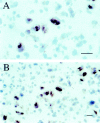Identification of a glioblastoma-associated tenascin-C isoform by a high affinity recombinant antibody
- PMID: 10329587
- PMCID: PMC1866608
- DOI: 10.1016/S0002-9440(10)65388-6
Identification of a glioblastoma-associated tenascin-C isoform by a high affinity recombinant antibody
Abstract
Tenascin-C exists in several polymorphic isoforms due to alternative splicing of nine fibronectin-like type III repeats. Large Tenascin-C isoforms are present in almost all normal adult tissues but are upregulated in fetal, regenerating, and neoplastic tissues. Here, we report a human antibody fragment, TN11, derived from a phage library with high affinity for the spliced repeat C and demonstrate that this repeat is undetectable in normal adult tissues, barely detectable or undetectable in breast, lung and gastric carcinomas, meningioma, and low grade astrocytoma, but extremely abundant in high grade astrocytoma (grade III and glioblastoma), especially around vascular structures and proliferating cells. The antibody appears to have potential for development of a therapeutic agent for patients with high grade astrocytoma.
Figures






References
-
- Folkman J: Angiogenesis in cancer, vascular, rheumathoid and other diseases. Nat Med 1995, 1:27-31 - PubMed
-
- Van den Hoff A: Stromal involvement in malignant growth. Adv Cancer Res 1988, 50:159-196 - PubMed
-
- Risau W, Lemmon V: Changes in the vascular extracellular matrix during embryonic vasculogenesis and angiogenesis. Devel Biol 1988, 125:441-450 - PubMed
-
- Ingber D, Folkman J: How does extracellular matrix control capillary morphogenesis? Cell 1989, 58:803-805 - PubMed
-
- Borsi L, Carnemolla B, Nicoló G, Spina B, Tanara G, Zardi L: Expression of different tenascin isoforms in normal, hyperplastic and neoplastic human breast tissues. Int J Cancer 1992, 52:688-692 - PubMed
Publication types
MeSH terms
Substances
LinkOut - more resources
Full Text Sources
Other Literature Sources

